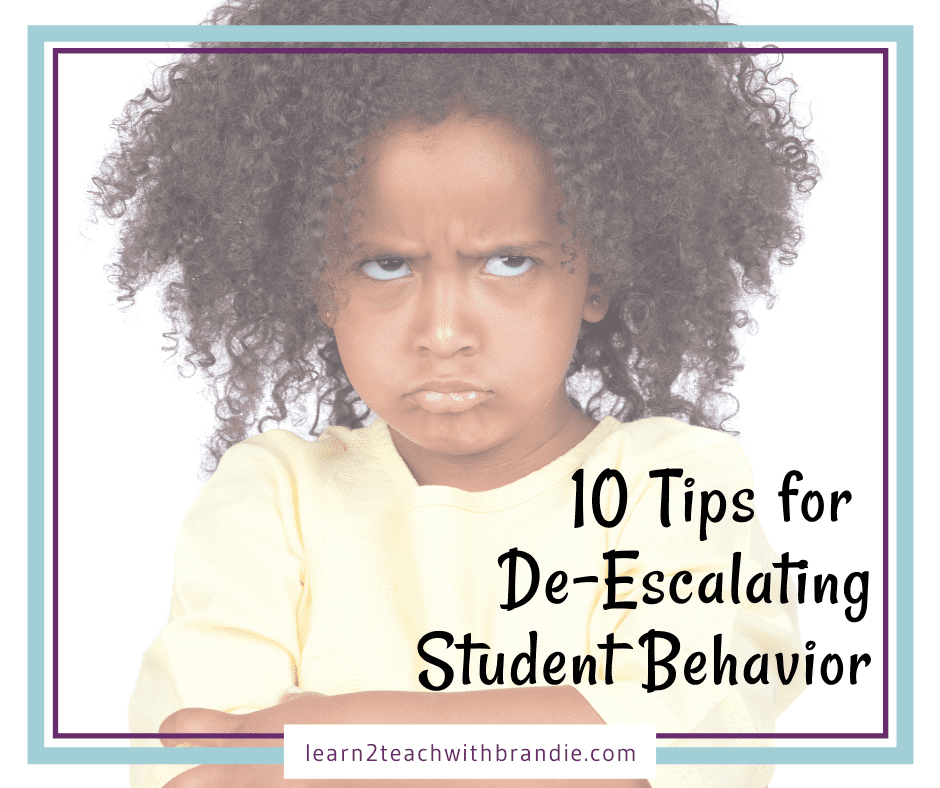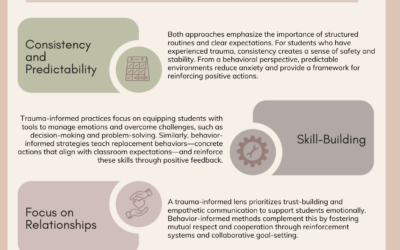Can a stack of tips solve tough student behavior issues? I know it’s not that simple. Changing behavior long-term takes a systematic approach like Bite-Size Behavior but you don’t always have the time and escalations can happen at any time. Here is a list of tips for de-escalating student behavior to have in your back pocket if a student escalates.
10 tips for de-escalating student behavior
1. Be aware of personal space:
Be aware of your position, posture, and proximity when interacting with an escalated student. Allowing personal space shows respect, keeps you safer, and tends to decrease a person’s anxiety. If you have to cross into someone’s personal space, explain what you’re doing so the person feels less confused and frightened.
2. Be aware of your non-verbal communication:
The more a student is escalated, the less they hear your words—and the more they react to your nonverbal communication. Be mindful of your gestures, facial expressions, movements, and tone of voice. Keeping your tone and body language neutral will go a long way toward defusing a situation.
3. Act Calm Even If You Aren’t
Remain calm, rational, and professional. While you can’t control the student’s behavior, how you respond to their behavior will have a direct effect on whether the situation escalates or defuses. This can be the most challenging part. It’s good to have a few things that you know help you stay calm BEFORE an escalation occurs.
4. Ignore Challenging Questions
Engaging with students who ask challenging questions is rarely productive. When a person challenges your authority, redirect their attention to the issue at hand. Ignore the challenge, but not the person. Oftentimes, people feel that it will make things better if they talk through things with the escalated student. This is rarely the case.
5. Set Limits
As a person progresses through a crisis, give them respectful, simple, and reasonable limits. Offer concise and respectful choices and consequences. A person who’s upset may not be able to focus on everything you say. Be clear, speak simply, and offer the positive choice first.
6. Really Think About The Demands You Are Placing
It’s important to be thoughtful in deciding which rules are negotiable and which are not. For example, if a student doesn’t want to sit at his desk, can you let him make another choice? If you can offer a person options and flexibility, you may be able to avoid unnecessary escalations. (This does not mean giving in on a regular basis just to “keep the peace.”)
7. Walk Away:
This may seem like a simple solution but sometimes it is really the BEST option. If you don’t feel like you can stay calm, or engaging with the student seems to be making things worse, walking away may be your best option. When walking away, understand that you will need to come back, but there is nothing wrong with taking a minute!
8. Remove The Audience:
Oftentimes when a student is escalated, having other kids around can make things worse. Sometimes students will be reinforced by the attention and sometimes the attention actually embarrasses them. Both of these situations may increase the escalation. If at all possible, removing other students can be helpful. If removing students isn’t possible, try to move the students to a different area.
9. Do What Works In The Moment:
I would NEVER pretend that I have all of the answers because I am not in the room with you. Sometimes what works in the moment is something that isn’t on any list. It may be something as random as opening a window, playing music, or putting a video on. Trying new things can be a great way to find the one thing that really works!
10. Reach Out For Help:
It is never a bad idea to ask for help. As teachers, we are trained to be able to do EVERYTHING on our own but sometimes just having someone there to bounce ideas off of or to lean on, is what you really need. Escalated student behavior can be VERY stressful and needing help doesn’t make you a bad teacher, it makes you human.





